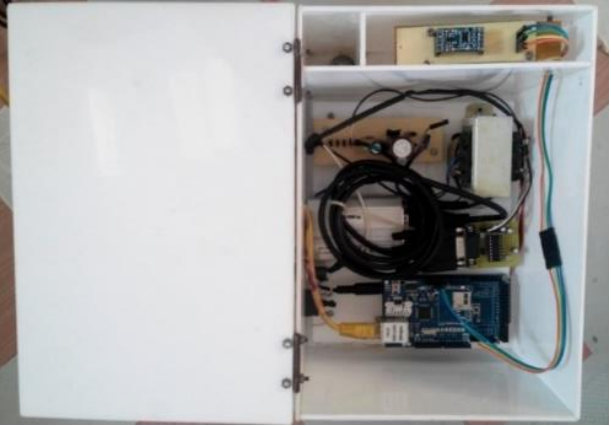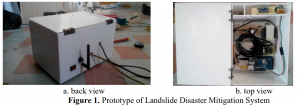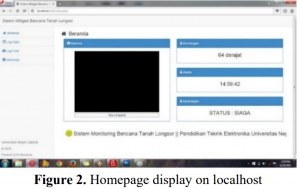
1.Introduction
The method used is research and development with a
prototyping model which is divided into several stages, namely stage (1) problems, (2) data
collection, (3) prototype design, (4) prototype testing, and (5) production. The resulting system
is a prototype based on an Arduino microcontroller called “ERT-Ladister” with an ADXL345
Gyroscope sensor. Other features include SMS-Gateway, buzzer, and Monitoring via Monitor.
Based on the feasibility test and the effectiveness test on a lab scale and field scale, it can be
concluded that the system is feasible and effective. The value of the effectiveness test shows
that there is a significant difference between before the system is installed and after the system
is installed in field trials. The Real-Time Landslide Early Disaster Mitigation Warning System
can increase community awareness around landslide-prone areas.
we will develop a disaster mitigation system that uses an accelerometer sensor to detect the occurrence of landslides and uses Arduino Mega 2560 to process the information received and SMS gateway as a processing system so that it can be easily monitored via mobile devices and browser monitors. It is hoped that this mitigation system can monitor
landslide-prone areas and provide information quickly via mobile devices or cell phones so that people
can immediately anticipate the disaster.
2. Method
The research method used to complete this research is to use research and development methods
(Research and Development) with a prototype model that includes problem identification, data
collection, Prototype Design, Prototype Testing, and Production. Small field trials were carried
out at LIPI Puspitek Serpong and field trials were carried out at 5 landslide-prone points in the Subang
area, Lebak Regency for a 3 month trial period.
3. Result and Discussion
3.1. Research result
The results of the research on Landslide Disaster Mitigation System Development Using the
ADXL345 Accelerometer Based on Web Localhost and SMS Gateway were obtained after conducting
a series of trials. This stage is carried out in order to find out how big the value of success in making
prototypes is in accordance with the program or system that has been created. The stages are testing
the ADXL345 Accelerometer sensor, Ethernet Shield, SMS Gateway, Webcam, and power supply
(Power Supply).

3.1.1. Component test results
In the component section there are several tests carried out including Accelerometer sensor testing,
Ethernet Shield testing, SMS Gateway delivery testing, webcam testing, and power supply circuit
testing.
3.1.2. Tilt test results ADXL345 accelerometer sensor
The test was carried out by changing the tilt position of the ADXL 345 accelerometer sensor using the
Arduino IDE 1.0.6 application. The data changes will be displayed through the serial monitor menu in
the Arduino IDE application. In addition, to produce a degree value, the data must be calibrated first
using a comparison. The following formula is used in the prototype of this system:
Sensor tilt angle = ((𝑦 − 5).90/(277−5))
Information:
y = Initial slope value
90 = Maximum slope angle
277 = Maximum limit of initial tilt angle
5 = Calibration value
After testing the sensor, the results are obtained as shown in table 1 below.
Table 1. ADXL 345 Test Results on Serial Monitor

So it can be concluded that the value of 0 degrees, starts from 5 bits and the maximum limit is 90
degrees, which is 277 bits.
3.1.3. Application test results
At this stage, the results obtained from testing entering data into the localhost database, testing the
database calling to the localhost web, and testing the status / conditions displayed on the Opera
browser with the Windows 7 operating system.

3.2. Discussion
Based on the overall test results that have been carried out, it is known that the Development of a
Landslide Disaster Mitigation System Using the ADXL 345 Accelerometer Based on Localhost Web
and SMS Gateway functions according to the plan. However, there are still some limitations that exist
in this system, namely:
The first discussion is that in component testing there are still some shortcomings, such as the IP
Address setting on the Ethernet Shield sometimes changes itself when uploading programs on the
Arduino IDE so to check it, you must use the help of the console command (CMD). The time frame
for sending data from Arduino Mega 2560 to the database using the Ethernet Shield is sometimes
interrupted even though the sending time has been set. For sending information via SMS, sometimes it
doesn’t reach its destination because the provider’s signal is experiencing interference, so it is
necessary to look for a provider card with a strong signal, reaching all corners, and rarely experiencing
interference. When using the webcam, you still have to click the button to take a picture because the
button is part of the .swf file so it can’t be created automatically.
With the additional interface in the form of a website application at localhost on Landslide Disaster
Mitigation System Development Using the ADXL 345 Accelerometer Based on Localhost Web and
SMS Gateway, it makes it easier to monitor an area prone to landslides. The researcher believes that
the prototype is very good in terms of providing information and can be a new alternative in
developing a disaster mitigation system for further research.
4. Conclusions and Suggestions
4.1. Conclusions
After identifying problems, collecting data, designing prototypes, and testing prototypes, the following
conclusions can be drawn:
4.1.1 Prototype for Landslide Disaster Mitigation System Development Using the ADXL 345
Accelerometer Based on Localhost Web and SMS Gateway has been designed with a slope limit of 30
degrees and can function as an information system that is quick to respond to landslide hazards
through mobile devices.
4.1.2 Mobile / Mobile devices can receive short messages warning of landslide hazards from the
prototype of Landslide Disaster Mitigation System Development Using the ADXL 345 Accelerometer
Based on Localhost Web and SMS Gateway.
4.2. Suggestions
In developing a prototype of a Landslide Disaster Mitigation System Using the ADXL 345
Accelerometer Based on Localhost Web and SMS Gateway, the researcher has several suggestions to
overcome and complete the system that will be used in this study.
• For the use of the Accelerometer sensor, use a sensor that is easy to find in the market so that
many tutorials can be found in books or the internet.
• First, calibrate the Accelerometer sensor so that the resulting value is as desired.
• Adding a website application on localhost to display the results of the Accelerometer sensor and
the data can be stored in the database.
• For database creation, create at least 2 databases to facilitate the data storage process.
• Adjust the delay of the Accelerometer sensor with the delay of sending data to localhost via
Ethernet Shield so that the results of the accelerometer can be read and stored in the localhost
database.
• When running this prototype open the Arduino IP address and the homepage of its mitigation
system in a browser with a different tab.


COMMENTS